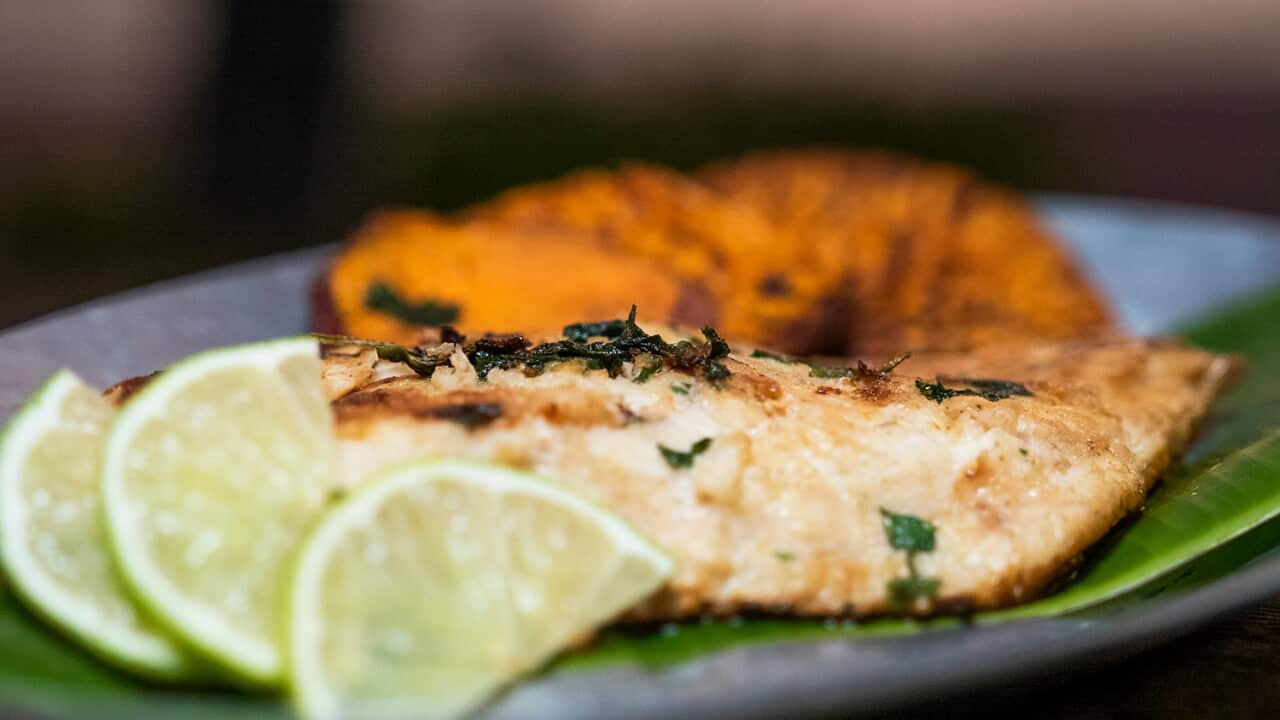--- Watch Aaron Fa'Aoso in Strait to the Plate on SBS Food, NITV, or stream it free on ---
Strait to the Plate is about connection.
Yes, it’s about food and wonderful cooks. Yes, it’s about a beautiful corner of Australia (and we’re not joking when we say the Torres Strait Islands should ready themselves for an influx of visitors who appreciate fresh air and endless seas and rich, ancient history).
But it’s so much more than a food and travel show. It’s about wonderful, vibrant, living connections to the sea and the earth and the seasons, to family and traditions. And it’s a joy to watch.
In this new five-part series, actor and producer Aaron Fa’Aoso takes us home to the Torres Strait, sharing the rich and varied food, people, history and culture of the islands, and the Torres Strait Islander communities on the mainland, where he grew up.

Food is at the heart of family gatherings in Strait to the Plate Source: NITV
Fa'Aoso says he learned to cook from his mother and grandmother, and from watching the great cooks among the men, too. For him, food is a true taste of home, and Strait to the Plate is a chance to share that with Australia, from seafood dishes cooked with fish straight from the sea to his grandmother’s cassava damper.

Sabi fish, one of many seafood dishes cooked up in Strait to the Plate. Source: Nicholas Beaney
Fa’Aoso, who's been , is involved in Strait to the Plate as both presenter and producer.
It’s a show made from the heart, and there’s more than one occasion where Fa'Aoso has a tear in his eyes, or a catch in his voice. Watching the series is a chance for viewers to understand some of the challenges that Torres Strait Islanders have faced in the past, and are facing now, such as the unequal wages paid to the many islanders who worked in the pearl fishing industry, the effect of western food on the health of many locals, and the danger to some homes of rising sea levels. Some of the islands face the very real threat of being totally engulfed by the sea in the near future.
But the series is full of joy, celebrations, and an abundance of good food too.
There are cooking lessons with good cooks from across the communities he visits; hunting, fishing and gathering trips; small meals and big feasts; and the sharing of many stories.
Is there one dish that always reminds you of your family and culture, we asked?
“I’ve been asked that a lot. It has to be my grandmother's cassava damper, which actually features in the series when I'm cooking it up with my Aunty Gladys, on my grandmother's porch. That just brings back memories because, whenever I returned home, when I would go back to visit my grandmother, without a doubt, I knew what was waiting for me, either in the fridge, or just being pulled out of the oven. I'd have a tray of cassava damper tray all to myself!”
Cassava appears a lot in Torres Strait cooking. “Cassava is an important garden food in our culture. As well as being a staple source of carbohydrates, it’s also packed within Vitamin C and other nutrients,” Fa’Aoso explains in the show, while cooking with his Aunty Gladys. “Like a lot of Torres Strait dishes, this dish is extremely labour-intensive. Our mothers’ hands are really strong because of all the scraping [to grate the cassava], and the digging in the ground for cassava.”
In a fine display of the interconnectedness of life, I mention to Fa’Aoso that I had seen a bisi damper (aka cassava damper) recipe on an item sold by a Torres Strait Island gallery, a teatowel by local artist Fiona Elisala. Fiona Elisala, it turns out, is Fa’Aoso’s cousin Fiona, whose wedding – and the joyous preparations, including preparation of enough food for around 300 guests – features in the series. (The is one of a series featuring Torres Strait Islander recipes and art, sold by , an Indigenous-owned and operated art centre on Moa Island.)
The close ties between culture and food are clear in Strait to the Plate.
Food, Fa‘Aoso says, is the end result of the practice of culture. “It’s intrinsically connected to the knowledge of seasonal patterns, knowledge of the elements, knowing when and where to hunt, what you are gathering, and the process of extracting what you need out of certain food plants or sea life… food and cooking is the end result of that. It’s connected to language, to ceremonies, your way of life, and the connectedness of coming together of family, and also in preserving and maintaining that in the 21st century."
And, he says, “you only take what you need. And then it’s about sharing as well... it's what our way of life is all about, you know, working in harmony and working in cooperation with one another.”
Fa’Aoso says he has been thinking about making this series for years, after he realised there were no TV shows about Torres Strait Island food. But it’s about all those things that connect to food, too.
The show starts with a visit to Badu, one of the larger islands, where Fa’Aoso meets a local artist whose work documents the seasons and traditional food knowledge, and who cooks up three dishes to give him a taste of local cuisine; reflects on the role many islanders played in the pearling industry; shares the first of several experiences that show the key importance of turtles to Torres Strait Islander communities, and how hunting has always been governed by strict cultural rules and sustainable practices; and is invited to a family feast.

A full table at a gathering on Badu Island. Source: NITV

Aaron Fa'aoso cooks with Aunty Gina Source: NITV
“I was always a big fan of pakalolo, but didn't know how the dish was made or cooked. So it was great. I wasn't aware of the gassi, I’d heard of it but didn’t know it was arrowroot. I was like ‘Arrowroot, man! Arrowroot! Like, you find that in the Straits? Shit yeah, I'm learning something today!'. Pakalolo is a signature dish from Poruma, so I was really blessed and humbled that we were able to capture that.” (Get the recipe .)

Pakalolo Source: Nicholas Beaney
The visit to Poruma ends with another feast, with families bringing dishes to share, all using ingredients from across the island and the sea.

Cassava balls (front) and cassava damper Source: NITV

Another trip out to sea Source: NITV
Making Strait to the Plate was about food, and so much more, Fa’Aoso says. “Part of it is exposing and giving light to a very much little known part of Australia, which is also the second First Nations culture in Australian First Nations culture.”
There’s a lot packed into five episodes, but the good news is that there’s more to come. Alongside several other projects, including a live action children’s series, a period drama and several documentary series, all anchored in the Torres Strait, he’s already thinking about the second series of Strait to the Plate. “I’m really excited about it. There’s just not enough Torres Strait content out there, and food is a perfect step into it for a lot of people. I’m looking forward to saddling up for more fun and enjoyable experiences.”






